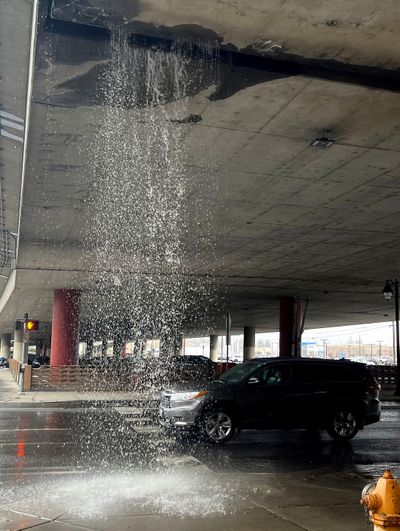Getting There: Water spewing from downtown I-90 viaduct ‘not a safety problem,’ state officials say

Drivers on Spokane’s lower South Hill may have been treated to a waterfall tour over the weekend.
Water tends to pour off the Interstate 90 viaduct over downtown Spokane after extended precipitation events, highlighted by the snowmelt and rainfall drizzling on the windshields of cars passing underneath.
Evan Grimm, a bridge engineer with the Washington Department of Transportation, said the trickles may be surprising but are not cause for alarm. The viaduct, as well as every other bridge in the state, is inspected regularly in accordance with federal law.
As of last year, the 2,765-foot structure had a fair rating, meaning it’s structurally sound despite a few minor deficiencies. Built in 1967, nearly 100,000 vehicles pass through Spokane on the I-90 viaduct every day, according to Federal Highway Administration data.
“All of the bridges in the state, if they’re open to traffic, it means they’re safe to drive on them,” Grimm said.
Grimm said the water coming off at intersections along West Fourth Avenue are likely due to a combination of things. The bridge is designed to have stormwater flow to drains along the shoulders of the roadway, but dirt, trash and vehicle debris can clog the pipes. Gravity then leads the water to find another path down, which tends to be through the expansion joints between large sections of the viaduct.
Those expansion joints are a crucial part of the design for a bridge as large as Spokane’s I-90 viaduct, Grimm said.
“When you have a long bridge that’s hundreds of feet, or in this case, like the I-90 in Spokane where it’s thousands of feet long, you have to have gaps in the bridge to allow the bridge to flex or to move with temperature changes,” Grimm said. “At those gaps, typically, what we’ll have is a rubber gland that seals it from water being able to come through.”
Due to repeated exposure to the elements over time, those rubber glands degrade and fail, leading to the waterfalls and icicles above the parking lots for Lewis and Clark High School students that occasionally appear.
“It’s really not a safety problem for the structure itself. It’s a maintenance issue that needs to be addressed.”
However, if the drainage through the expansion joints is not addressed, it could degrade some of the bridge’s structural elements, Grimm said.
“You have all these salts in the roadway that’ll be coming down and coming against these concrete structural elements, and we’ll start to see greater degradation,” Grimm said. “So we do want to keep all the drains function in the way they should, and keep those glands at the joints functioning the way they should, but we don’t always have enough funding resources to keep on top of it like we’d like to.”
Mike Frucci, an assistant regional administrator for the agency’s maintenance and operations, said the Eastern Washington maintenance team routinely cleans the drains and roadside to keep the stormwater system operating appropriately. He said any needed repair to the glands will be addressed when possible, because the team is spread across seven counties and needs to prioritize work accordingly.
Transportation department spokesman Ryan Overton said oftentimes, members of the public are the ones who bring maintenance issues to the state agency’s attention. If travelers notice a pothole opening up, an expansion joint coming up out of a bridge deck or have any other concerns about state roadways, they can contact the department’s 24/7 Traffic Management Center.
“We appreciate folks making the time to get a hold of us when they see things,” Overton said.